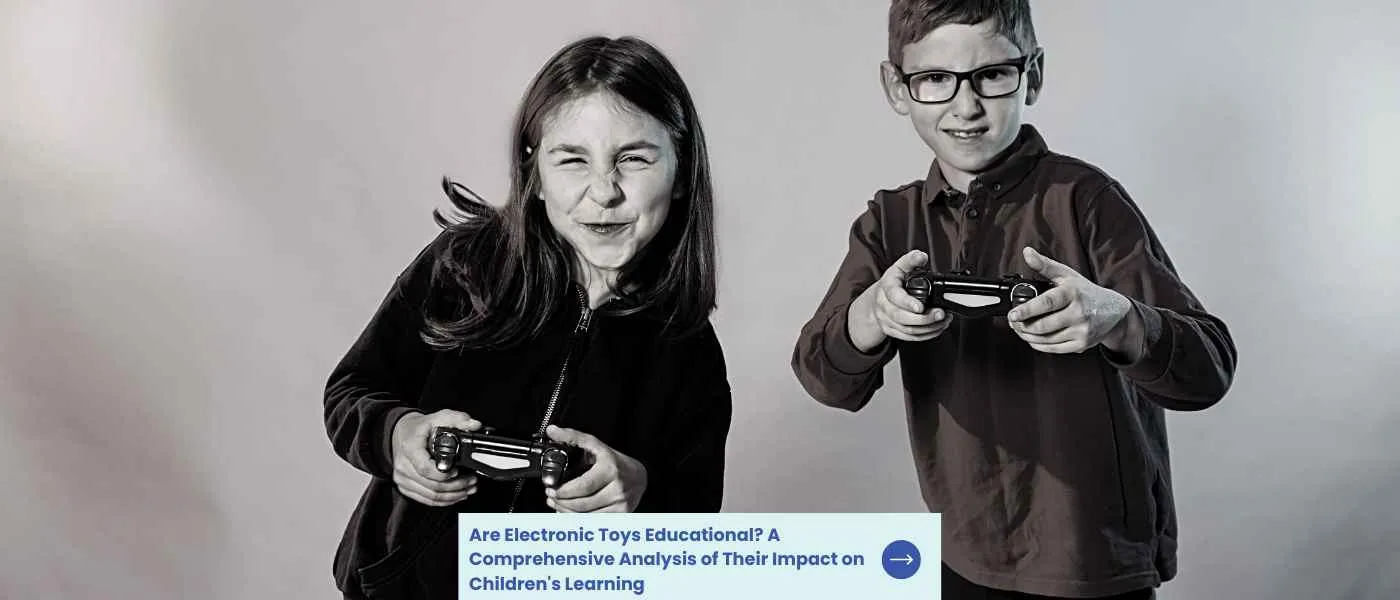In today’s technology-driven world, parents and educators alike are constantly seeking ways to ensure children receive the best education possible. With the rise of electronic toys, a key question has emerged: are these gadgets truly educational, or are they just another distraction?
This blog post aims to provide a comprehensive analysis of the impact electronic toys have on children’s learning, exploring the advantages and disadvantages of incorporating these high-tech playthings into their educational journey.
Join us as we delve into the world of electronic toys, examining their potential to enhance cognitive development and support essential life skills, while also discussing the potential pitfalls and challenges that may arise from their use.
Key Takeaways on Electronic Gadgets and Toys for Early Learning and Development
- Electronic toys can be a great way to promote cognitive development, motor skills, and social interaction for children.
- Electronic toys can be a great way to engage and entertain children, but it’s important to consider the type of toy that best suits your family’s needs.
- To choose the right electronic toy for a child, consider their age and abilities, look for educational content, check for quality and durability, and read online reviews before making a purchase.
What Are the Developmental Benefits of Electronic Toys?
Electronic toys can offer a range of cognitive, motor and social benefits for children. From educational apps to interactive toys, there are plenty of options available that can help your child learn and grow. Here’s a look at the advantages of using toys to support your child’s development.
Cognitive development
Electronic toys can provide an engaging way for kids to practice solving problems as they work through puzzles or navigate virtual worlds. Educational apps also allow children to explore topics like math, science and language in fun ways that make learning more enjoyable.
Motor skills
Many electronic games require players to use their hands or fingers in order to play, which helps develop fine motor skills such as dexterity and coordination. Interactive toys often involve physical movement too, such as dancing along with music or playing sports games on a console controller.

Social interaction
While it may seem counterintuitive, some electronic games actually promote social interaction between kids and family members who are playing together online or in person (depending on the game). For example, multiplayer video games encourage teamwork while also teaching other forms of communication skills like turn taking, talking, speaking and listening carefully to others’ ideas.

Language Development
Electronic toys that have interactive features and encourage children to speak, such as voice-activated games, can help promote language development in kids. These toys can provide opportunities for children to practice their language skills, vocabulary, grammar, and pronunciation in a fun and engaging way.
Additionally, toys can also help children learn about cause and effect and improve their skills, which can contribute to overall cognitive development.
However, a research study from Northern Arizona University found that when children played with electronic toys, there was less parent-child interaction and fewer words used by parents, compared to when children played with books or traditional toys.
What Are the Different Types of Electronic Toys?
Electronic toys such as the baby laptop and toy cars have been gaining popularity among kids due to their interactive and engaging features. These toys often incorporate technology such as touch screens, sensors, and voice recognition to provide a more immersive experience. Parents also appreciate the educational and developmental benefits that many electronic toys offer to a young child.
Video games
Video games are a popular type of electronic toy that can be found in many households. They range from simple, easy-to-learn titles to complex and immersive experiences. Depending on the game, they can help kids develop problem solving skills, hand-eye coordination, and even social interaction. Many video games also feature educational content such as math or science puzzles that can help kids learn while having fun.
Apps
Educational apps are another type of electronic toy that parents may want to consider for their children. These apps often focus on specific topics like language or mathematics and provide an interactive way for kids to explore these subjects at their own pace.
Educational apps come in a variety of formats including flashcards, quizzes, and mini-games which make them engaging for both younger and older children alike.
Modern interactive toys
Interactive toys are another great option when it comes to battery-operated toys for kids. These toys usually have some sort of screen or display built into them which allows the user to interact with the device in various ways such as playing music or controlling characters on the screen with buttons or motion sensors.
Interactive toys can help promote creativity by allowing users to make pictures and create stories using characters from their favorite movies or TV shows while also teaching basic coding concepts through playtime activities like programming robots or creating digital art projects.

How to Choose the Right Toy for Your Child’s Age and Interests
When it comes to choosing the right toy for your child, there are a few key factors to consider.
- Age and abilities should be taken into account when selecting an electronic toy. Look for toys that are designed specifically for the age group of your child and ones that will challenge them without being too difficult or overwhelming.
- Look for features like adjustable difficulty levels or multiple game modes that allow children to progress at their own pace.
- For younger children who may not have developed fine motor skills yet, look for games with large buttons or touchscreens with larger icons which can make it easier to interact with the device.
- Some devices offer parental controls which allow parents to set limits on usage time or access certain content depending on their preferences.
- Educational content is also important, as these types of toys can help support developmental goals in areas such as language development and more.
- Make sure you check for quality and durability standards so that the toy lasts through playtime.
- Consider educational content when choosing an electronic toy. Many apps feature interactive activities such as puzzles or matching games which can help develop skills while providing entertainment at the same time.
- Some devices even come preloaded with educational videos featuring topics such as science experiments or foreign languages which can provide a fun way of introducing new concepts in a hands-on manner.
- Check out reviews online. This will provide insight into the quality and durability standards that should be expected from the product.
- All parts should be securely attached so they do not break off easily during playtime; this includes batteries if applicable.
- Note any additional accessories included with the purchase as these can increase its value over time.
Tips for Using Electronic Toys Responsibly With Kids
It’s important to use electronic toys responsibly with kids! Here are some tips for making sure your child or toddler is getting the most out of their screen time.
Set time limits on screen time usage
It’s important to set limits on how much time your child spends on a smart phone or cell phone. The American Academy of Pediatrics recommends limiting children under 18 months old from using any type of screen media, and those between 2-5 years should have no more than 1 hour per day. For older children, you can decide what works best for them based on their individual needs and interests. Spending too much time on screens can lead to attention span issues.

Encourage balance between screen time and other activities
Older kids and toddlers learn through play and while its okay for them to play games with electric toys, it should be one in moderation for a few minutes. It’s also important to encourage balance by engaging in other activities such as reading books together or going outside for a walk or bike ride. This will help ensure that they are developing skills in multiple areas while still having fun with technology.
Monitor content to ensure it is appropriate for your child’s age and interests
When selecting an appropriate game or app for your child, make sure that the content is age-appropriate and relevant to their interests. Also be aware of any advertisements within the game as these may not always be suitable for younger audiences. Additionally, look into parental controls so you can limit access if needed.
Alternatives to Electronic Toys That Promote Learning Through Play
In a world where technology is becoming increasingly ubiquitous, it’s no surprise that electronic toys are becoming more and more popular among parents looking to keep their kids entertained and engaged.
However, while these toys may offer immediate gratification and excitement, they often lack the long-term benefits that come with more traditional forms of play. Fortunately, there are plenty of alternatives to electronic toys that can promote educational through play in a way that is both engaging and beneficial for kids of all ages.
Wooden toys
Wooden toys & puzzles are a great alternative to electronic toys that promote growth through play. They provide an open-ended form of play, encouraging children to use their imaginations as they explore the possibilities.
Wooden puzzles help develop hand-eye coordination, while wooden building blocks, can be used for building structures or creating stories with characters. There is no limit to what your child can create with these types of toys!
Arts and crafts
Arts and crafts Supplies are another excellent way to encourage creative thinking in kids. From coloring books and crayons, markers, paint sets, clay kits and more – there’s something for every age group.
Arts & crafts supplies help children express themselves creatively while also developing fine motor skills like drawing shapes or cutting paper into different sizes. Plus it’s fun too!
Outdoor toys
Outdoor play equipment is a great way to get kids moving and using their bodies in creative ways. Swing sets, trampolines, climbing walls – all of these activities help build strength and coordination while having fun at the same time.
Outdoor play equipment encourages physical activity which helps keep kids healthy both physically and mentally by providing them with fresh air as well as exercise opportunities that stimulate the brain’s cognitive development.

Are Traditional Toys Better Than Electronic Toys?
Traditional toys have many advantages over electronic toys, making them a better option for children. Here are some reasons why:
- Unlike electronic toys, wooden toys are free of hazardous materials such as lead, mercury, and cadmium. Wooden toys do not have small parts that can be a choking hazard, making them a safer option for young children.
- Traditional toys do not have preset functions and are open-ended, allowing children to use their imagination and creativity to come up with their own games and stories. This can help develop critical thinking, and creativity in children.
- Electronic toys are often made of plastic and can break easily if they are dropped or mishandled. On the other hand, wooden toys are more durable and can last for many years, making them a more sustainable option.
- Most traditional toys are made from sustainable materials, and their production does not contribute to environmental pollution. Electronic toys, on the other hand, require batteries and are often made of non-biodegradable materials, leading to environmental concerns.
- Traditional toys have a tactile feel and provide a sensory experience for children. They can help develop fine motor skills, hand-eye coordination, and other sensory abilities in young children.
Traditional toys offer a safer, more sustainable, and more creative play experience for children compared to electronic toys. They promote sensory growth, encourage creativity, and are made of eco-friendly materials, making them a better option than high tech toys for parents looking to provide their children with quality toys.
FAQs on Toys for Brain Development
What Are Considered Educational Toys?
Educational toys are those that encourage growth in children. They can range from traditional wooden blocks, puzzles, and construction sets to more modern electronic devices such as tablets or computers.
Educational toys help develop skills such as fine motor coordination, language development, creativity and imagination. These types of toys also promote social interaction between children by encouraging them to work together on tasks or activities.
Additionally, educational toys often have an element of fun which makes them enjoyable for little kids to play with while still providing a valuable learning experience.
Can Toys Be Educational?
Yes, toys can be educational. Wooden toys and open-ended play encourage kids to use their imaginations and develop problem solving skills. By providing children with zero waste plastic free products, families are teaching them the importance of sustainability and environmental responsibility.
Toys that promote creativity, exploration using little hands, human interaction, make a story, discovery and learning can help foster a child’s development in many areas such as language acquisition, cognitive thinking skills and social interactions.
Are Electronic Toys Good for Toddlers?
Electronic toys can be beneficial for toddlers, depending on the type of toy and how it is used. These toys that encourage interactive play, such as those with educational content or games, can help develop hand-eye coordination. However, too much screen time can have a negative impact on development and should be limited to an hour per day.
Additionally, these toys may contain small parts that pose a choking hazard to babies and young children. Therefore, when selecting battery-operated toys for babies and toddlers it is important to consider safety first and ensure they are age appropriate.

Do You Believe Playing With Electronic Toys Has a Good Influence on Children?
It is difficult to definitively answer this question without considering the individual child and family. Electronic toys can provide a range of educational opportunities, from teaching basic skills such as counting or letter recognition, to more complex tasks.
However, these toys can also be overstimulating for some children and may not promote creativity in the same way that open-ended play with wooden toys does.
Ultimately, it is up to parents to decide what type of toy best suits their child or toddler’s needs and interests while still encouraging creative play.





